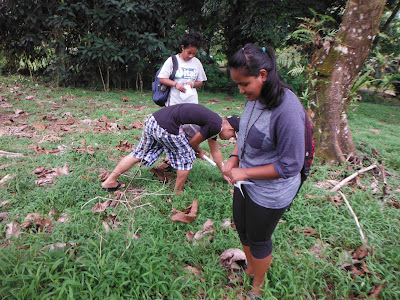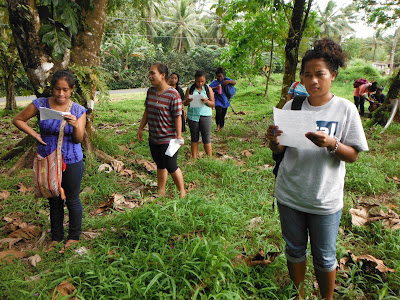Assessing Learning in Ethnobotany
SC/SS 115 Ethnobotany proposes to serve four program learning outcomes through three course level outcomes. The course serves learning outcomes in general education, the Micronesian studies program, and the Agriculture and Natural Resources program.
CLO 1
Identify local plants, their reproductive strategies, and morphology.
The twenty-four students in the course engaged in a number of activities in support of this learning outcome. Vegetative morphology was supported by a field identification walks and presentations. Reproductive strategies were also communicated via student presentations. Identification of local plants permeated every outing, field trip, and hike.
Twenty-two of the twenty-four students attended the field final examination exercise. Of the two students who did not attend the final examination one student had irregular attendance from August into early November, and then stopped attending the class altogether in November. The other student who missed the field final examination cited personal reasons for missing the field final examination.
The final examination involved a walk on campus and required the twenty-two students present to identify sixteen randomly chosen local plants both by local and Latin names. The students correctly made 338 local name identifications out of 352 possible identifications for a rate of 96% This success rate was essentially identical to the success rate of 97% for the students spring term 2015.
Identifying plants in their own language is a more difficult task than one might expect. Despite the students being fluent in their first language, they often do not know their local plant names.
For the Latin name identifications the students had a list of 63 Latin names from which to work. The students collectively made 340 correct Latin name matches out of 352 possible. This was a success rate of 97%. This success rate was higher than the 84% success rate of spring 2014, however if one re-includes the two absent students as being zero success rates, then the success rate falls to 89%.
CLO 2
Communicate and describe the cultural use of local plants for healing, as food, as raw materials, and in traditional social contexts.
Students engaged in presentations on healing plants, plants as food, and wrote two essays during the course of the term on the cultural use of plants. Essays were marked using rubrics provided one the day one calendar and syllabus.
The final examination asked students to provide uses for the sixteen plants on the final examination. Students collectively provided 341 uses out of 352 possible. This represents a 97% success rate, essentially the same as the spring 2015 success rate of 93%.
The two essays suffered from low turn-in rates. Thirteen of the 24 students (54%) turned in the first essay on healing plant usage. Nine of those essays were submitted on time (69% on-time), the rest were up to a week late. The grace period on late turn-in was one week. The second essay on the loss of material culture saw an improved turn-in rate of 15 papers submitted (63%), but only seven were on time (47% on-time). The average for the first essay was 71%, the second essay was 73%. Performance was generally weak.
CLO 3
Demonstrate basic field work competencies related to management of culturally useful plant resources and foods.
Students tended to a banana tree collection and engaged in maintaining ethnobotanical plant collections on campus.
| PLO | SC/SS 115 CLO |
|---|---|
| GE 3.4 Define and explain scientific concepts, principles, and theories of a field of science. | 1. Identify local plants, their reproductive strategies, and morphology. |
| GE 4.2 Demonstrate knowledge of the cultural issues of a person’s own culture and other cultures. MSP 2 Demonstrate proficiency in the geographical, historical, and cultural literacy of the Micronesian region. | 2. Communicate and describe the cultural use of local plants for healing, as food, as raw materials, and in traditional social contexts. |
| ANR 2 Demonstrate basic competencies in the management of land resources and food production. | 3. Demonstrate basic field work competencies related to management of culturally useful plant resources and foods. |
CLO 1
Identify local plants, their reproductive strategies, and morphology.
The twenty-four students in the course engaged in a number of activities in support of this learning outcome. Vegetative morphology was supported by a field identification walks and presentations. Reproductive strategies were also communicated via student presentations. Identification of local plants permeated every outing, field trip, and hike.
Erica amidst Ischaemum polystachum
Twenty-two of the twenty-four students attended the field final examination exercise. Of the two students who did not attend the final examination one student had irregular attendance from August into early November, and then stopped attending the class altogether in November. The other student who missed the field final examination cited personal reasons for missing the field final examination.
The final examination involved a walk on campus and required the twenty-two students present to identify sixteen randomly chosen local plants both by local and Latin names. The students correctly made 338 local name identifications out of 352 possible identifications for a rate of 96% This success rate was essentially identical to the success rate of 97% for the students spring term 2015.
Identifying plants in their own language is a more difficult task than one might expect. Despite the students being fluent in their first language, they often do not know their local plant names.
For the Latin name identifications the students had a list of 63 Latin names from which to work. The students collectively made 340 correct Latin name matches out of 352 possible. This was a success rate of 97%. This success rate was higher than the 84% success rate of spring 2014, however if one re-includes the two absent students as being zero success rates, then the success rate falls to 89%.
CLO 2
Communicate and describe the cultural use of local plants for healing, as food, as raw materials, and in traditional social contexts.
Students engaged in presentations on healing plants, plants as food, and wrote two essays during the course of the term on the cultural use of plants. Essays were marked using rubrics provided one the day one calendar and syllabus.
Fritz Mihkel used the core of an already flowered banana stalk to produce cough medicine. The center of the core is effectively drilled out to allow the liquid in the false stem to collect. The core has to be already flowered, or the banana will regrow into the center hole that was drilled out. The gathered liquid is then drunk to relieve coughing.
The final examination asked students to provide uses for the sixteen plants on the final examination. Students collectively provided 341 uses out of 352 possible. This represents a 97% success rate, essentially the same as the spring 2015 success rate of 93%.
The two essays suffered from low turn-in rates. Thirteen of the 24 students (54%) turned in the first essay on healing plant usage. Nine of those essays were submitted on time (69% on-time), the rest were up to a week late. The grace period on late turn-in was one week. The second essay on the loss of material culture saw an improved turn-in rate of 15 papers submitted (63%), but only seven were on time (47% on-time). The average for the first essay was 71%, the second essay was 73%. Performance was generally weak.
CLO 3
Demonstrate basic field work competencies related to management of culturally useful plant resources and foods.
Students tended to a banana tree collection and engaged in maintaining ethnobotanical plant collections on campus.
Stacy
The students worked with bananas from production on the land to the kitchen to the table. The collection also provided a living banana herbarium and assisted in teaching students the diversity of bananas.
Erika Billen, Michelle David, Myreesha Daniel, and Starcy Rodriguez with their dishes.
Banana chips
Students also tended to ethnobotanically useful plant collections and learned to identify threats to
production such as invasive species.
Dissotis rotundifolia. Melastomataceae. Also known as Spanish shawl, Pinklady, trailing dissotis. May also be known as trailing Tibouchina. A member of Melastomaceae, also known as Melastomataceae. Other members include Clidemia hirta and Melastoma malabathricum var. marianum (the lattermost being a local medicinal plant).
Shannon, Aiesha-Lane in the field learning invasive species











Comments
Post a Comment